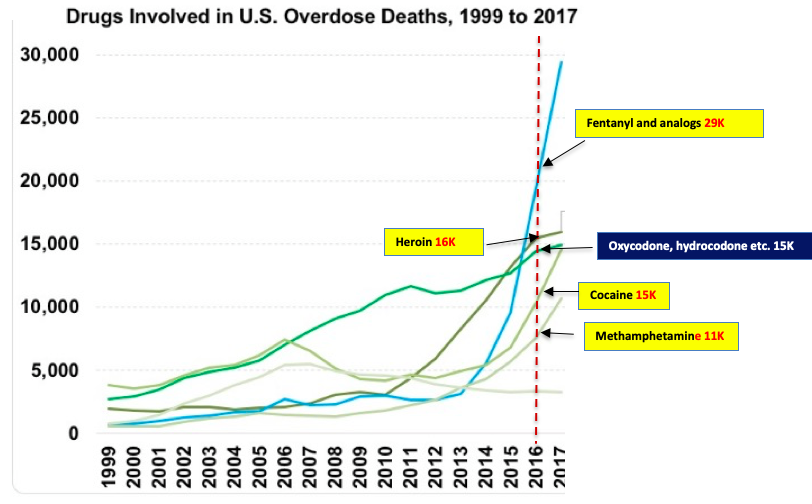You have to give them credit for getting to the point quickly enough.
Dr. Katherine Sleeman and Professor Sir John Strang of King's College in London don't mess around:
"Opioids: Why 'dangerous' drugs are still being used to treat pain"
Sleeman and Strang writing for BBC News, demonstrate that a mere ocean can't stop anti-opioid hysteria. No – needless suffering is not a function of geography, only orthodoxy. It does not take long to figure this out. Like in the first sentence (emphasis mine)...
"The widespread use of opioids to treat pain frequently prompts concerns about addiction and even deaths. So, why are these sometimes dangerous drugs still being given to patients?"
This question is just too stupid to answer so I'm not going to.
Nor does it take long for deceptive language – the hallmark of the fake "opioid crisis" – to make its appearance...
"These drugs - including morphine, tramadol and fentanyl - are used to treat pain caused by everything from heart attacks to cancer."
Are they kidding?? Tramadol and fentanyl don't even belong in the same sentence. Tramadol is the weakest prescription opioid (1) and fentanyl is the strongest. This is like saying "to avoid painful foot injuries while at the beach be careful to avoid stepping on clam shells and putting your foot into the mouth of a ravenous great white shark." And if a terminal cancer patient is getting only tramadol for pain this is tantamount to medical torture.
"But in the UK they were recently linked to the deaths of hundreds of elderly hospital patients, while the US is battling a well-documented opioid epidemic."
Yes, this is probably true. Elderly patients are not in the hospital to play shuffleboard. They are ill. Many have cancer. If morphine is given to elderly, terminally ill patients some will die. And if a Hershey Bar is given to elderly, terminally ill patients some will die. And, yes - the US is "battling" – bungling, really – an epidemic, but it is not an opioid epidemic. It is a fentanyl epidemic. Fentanyl and its ferocious analogs are the great white shark. Tramadol is the clamshell.
"Why not just use other painkillers to avoid the risk of harm?"
Because they suck.
Next, we have this doozie (emphasis mine):
"However, opioid receptors are present in areas of the brain responsible for breath control and high doses can dangerously reduce the rate of breathing - the cause of almost all opioid deaths."
Since anti-opioid zealots in the US routinely (and intentionally) avoid the discussion of dose – therapeutic vs. lethal – then the UK is perfectly within its sovereign rights to do the same. One 10 mg Percocet pill will kill a person only if he/she chokes on it. Two-hundred of them at once will kill anyone. Sleeman and Strang seem oblivious to the fact that there exists a range of doses at which pain can be relieved without the patient stopping breathing.
"In the US, the increasingly widespread prescription of opioids to treat long-term pain has led to an epidemic of addiction. In 2016...there were 42,249 deaths from overdoses."
This is a big pile of trans-Atlantic BS. 42,249 deaths? Let's take a look at that number (Figure 1).

Figure 1. US overdose deaths 1999-2017. The year 2016 is denoted by the hatch red line. Source: Adapted from the National Institute on Drug Abuse (NIH)
Figure 1 shows one of the most common lies or distortions used by the anti-opioid cabal – combining different drugs that should not be combined to single classes in order to make the disingenuous case that "opioids," meaning pills, are killing a whole lot more people than they really are. Therefore to "protect the masses" they need to keep those nasty pills away, whether patients like it or not. This sleazy tactic has been used many times (with great success) on this side of the Atlantic (See Who Is Telling The Truth About Prescription Opioid Deaths? DEA? CDC? Neither?). Fortunately, we do not bestow titles of royalty here, such as was done with co-author Professor Sir John Strang. At least not officially...
"There were more than 2,000 deaths in England related to opioid overdose in 2016, the highest since records began. But unlike the US deaths, these largely related to heroin rather than forms of opioid available on prescription."
Big. Fat. British. Lie. Illicit fentanyl and its analogs, and heroin, not prescription pills, are the killers in the US. And by a lot – something that Figure 2 makes quite obvious.

Figure 2. (Left) Fentanyl deaths in the US increased by about 25,400 between 2013-2017. Deaths from all opioids (Right) increased by 22,600 during that same time. Coincidence? I think not. Source: CDC National Center for Health Statistics. CDC WONDER database. Released 2018.
There's plenty more, some of it even makes sense, but enough already. I propose a deal with Great Britain: We both have enough problems - you keep yours and we'll keep ours...
NOTES:
(1) Tramadol is called an "atypical opioid." It isn't nearly as effective as hydrocodone or oxycodone, but giving it the opioid label enables the professional busybodies another drug to go after. Tramadol became a Schedule IV drug in 2014.



